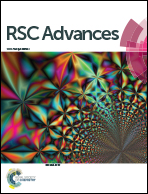Theoretical study on complexation of U(vi) with ODA, IDA and TDA based on density functional theory†
Abstract
This study aims to understand the complexation of U(VI) with oxydiacetic acid (ODA), iminodiacetic acid (IDA) and thiodiacetic acid (TDA) through density functional theory (DFT) calculations. The structures, complexation stabilities and bonding nature were investigated for U(VI)/XDA complexes (XDA is short for the three ligands). The calculations have proved that tridentate structures are more favorable than terminal bidentate ones for all stoichiometries, and steric hindrance is a factor that cannot be ignored especially for 1 : 2 complexes. The binding stabilities of the ligands and relative binding groups are in the sequences IDA > ODA ≫ TDA and C![[double bond, length as m-dash]](https://www.rsc.org/images/entities/char_e001.gif) O > OH− ≫ H2O > X (Oether, N and S), respectively. All of the coordination bonds exhibit typically ionic character. The coordination bonds are mainly contributed by the interactions of U 5f-orbital and O(
O > OH− ≫ H2O > X (Oether, N and S), respectively. All of the coordination bonds exhibit typically ionic character. The coordination bonds are mainly contributed by the interactions of U 5f-orbital and O(![[double bond, length as m-dash]](https://www.rsc.org/images/entities/char_e001.gif) C)/X p-orbitals. The strength of all coordination bonds follows the order U–O(
C)/X p-orbitals. The strength of all coordination bonds follows the order U–O(![[double bond, length as m-dash]](https://www.rsc.org/images/entities/char_e001.gif) C) > U–N > U–O(H2) ≈ U–Oether > U–S. U–S interaction was solidly confirmed by MO and AIM analysis, which is found for U(VI)/TDA complexes for the first time. U–X bonds play an important role in U(VI)/XDA coordination.
C) > U–N > U–O(H2) ≈ U–Oether > U–S. U–S interaction was solidly confirmed by MO and AIM analysis, which is found for U(VI)/TDA complexes for the first time. U–X bonds play an important role in U(VI)/XDA coordination.


 Please wait while we load your content...
Please wait while we load your content...